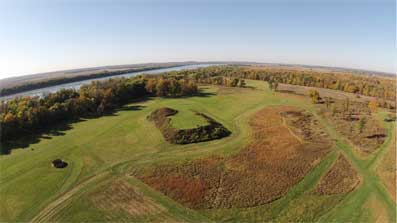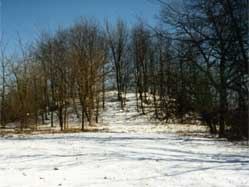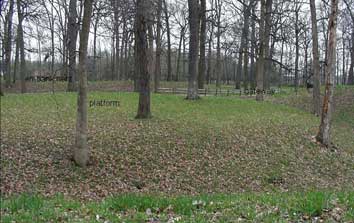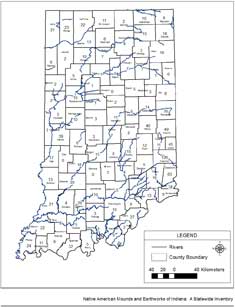Main Content
Article
Indiana's Prehistoric Mounds and Earthworks
The Department of Natural Resources, Division of Historic Preservation & Archaeology (DHPA) worked with several key archaeology partners in 2008 to propose an inventory of the reported and known pre-European-contact Native American mounds and earthworks sites throughout the state.

What are Earthworks?
Earthworks are Native American constructions that are systematically formed into mounded walls and elevated areas.
Mounds:
Mounds are constructions that are elevated and can be tall and conical, or low and rounded, or even flat-topped. They can be made of earth, shell, or stone.
Enclosures:
Enclosures generally feature a bank and ditch construction, can be circular, rectangular/subrectangular, or geometric in shape, and usually feature at least one entrance or gateway through the bank.
Earthwork Complexes:
Earthwork complexes are groupings of enclosures and/or mounds in proximity to each other.
All of these earthwork types had ritual and/or mortuary functions. But these functions may have differed between feature types and in different locations.
What we learned

This inventory resulted in the documentation of 1,183 sites that contain at least 2,100 individual earthworks. This project was entirely a search of records and literature; no field work, survey, or investigation was performed. The inventory showed that virtually all of Indiana’s earthworks have been damaged by uncontrolled digging and various agricultural and construction activities. Most of the sites need additional investigations to record more precise locations and to document their current conditions since many of them have not been visited by an archaeologist in several decades. Additionally, few of the earthworks have excavation data that allow for a determination of age and cultural affiliation.
Documentation of Indiana’s earthworks began as early as the 1790s and shows that mounds and other earthworks are found in almost every county. Several patterns in the records are apparent.
- Almost all the earthworks in the state were reported to archaeologists and were not discovered through systematic archaeological investigations.
- Virtually every earthwork has been damaged, primarily through uncontrolled digging by curiosity seekers.
- Of the earthworks that were visited by an archaeologist, many have not been checked in several decades, some in more than 50 years.
- Many of the reported mounds that have been visited by an archaeologist were found to be natural features, rather than being man-made earthworks created by glacial activity and erosion and oftentimes contain burials.
- There is a distinct lack of recorded data from earthwork sites, from basic size measurements to details of excavations. Further, much of the excavation data from early investigations is so generalized as to be of limited usefulness in defining horizontal and vertical stratigraphy, chronology, and context for features within sites.
- Site locations are, in general, poorly recorded and the majority of earthworks require field checking to acquire accurate locations.
Overall, these patterns reveal that earthworks within the state are very poorly documented.

Where to go from here
- Standardization of site types - A significant challenge to the records search was the various ways in which mounds and earthworks were identified and described. Early recording of these resources leaves a lot of room for errors in location, type and associated sites. Going forward, the project partners agreed that a system that standardizes these types of sites will help reduce confusion and help archaeologists better identify, document, and assess mounds and earthworks.
- Continued education/training in the archaeology community - Mounds and earthworks are a specific type of site and require a certain level of understanding and training to identify and assess. Providing continued education and training to professionals, avocationals, and even the general public will help protect the mounds and earthworks that remain.
- Field verification of mounds and earthworks - Many of the sites identified through this project have vague location information, have not been visited by professional archaeologists, or are in rapidly developing areas. It is important for qualified archaeologists to assess and document sites that are endangered or about which little is known.
- Listing mounds and earthworks in the National Register of Historic Places - As field verification and investigation is undertaken, sites should be determined for eligibility to the National Register. In some cases, sites may be individually eligible, but sites that share cultural affiliations may benefit from a Multiple Property Documentation Form that would establish criteria for listing for specific kinds of mounds and earthworks.
DHPA continues to maintain and update the inventory of Indiana’s mounds and earthworks.
What can you do?
- Report looting or damage to a mound or earthwork.
- Become an advocate for the preservation of archaeological sites:
- Understand the laws that protect archaeology sites in Indiana;
- Encourage others to learn about mounds and earthworks;
- Support efforts to have more mounds and earthworks listed in the National Register of Historic Places;
- Participate in Indiana Archaeology Month activities;
- Donate to archaeology efforts such as the Archeology Preservation Trust Fund
- Encourage government, planning and development agencies to respect archaeological sites;
- Advocate for more funding for archaeological projects.
- Be a heritage tourist and visit mound sites that are open to the public and learn more about these important places:

Where can you learn more?
General Indiana archaeology resources:
- Midwest Mounds
- The Archaeology of Mounds State Park, Anderson, Indiana
- Preservation of Indiana mounds by The Archaeological Conservancy
Project Partners
Archaeologists responsible for the statewide research were from:
- University of Notre Dame
- Indiana University-Purdue University Fort Wayne
- Ball State University
- Gray & Pape, Inc
The Preserve America program is a federal initiative that encourages and supports community efforts to preserve and enjoy our priceless cultural and natural heritage. The goals of the program include a greater shared knowledge about the nation's past, strengthened regional identities and local pride, increased local participation in preserving the country's cultural and natural heritage assets, and support for the economic vitality of our communities.
